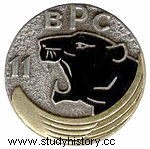
The 11th Shock is an elite parachute unit of the French Army that has had several names throughout its history. It was formerly the armed wing of the Action service of the External Documentation and Counterintelligence Service (SDECE).
Creation and different denominations
September 1, 1946:creation in Mont-Louis of the 11th parachute shock battalion (11th BPC) from the 3rd battalion ("Commando de France" and "Commando de Cluny") of the 1st shock regiment;
January 1, 1955:creation of the combat swimmers section within the Collioure nautical center;
June 4, 1955:decision to create the 11th shock paratrooper demi-brigade (11th DBPC );
October 1, 1955:creation of the 11th DBPC in Perpignan;
April 16, 1956:creation of instruction centers (CI) n° 1 (“ transmissions” in Perpignan), n° 2 (“guerrilla” in Mont-Louis), n° 3 (center of Saut), n° 4 (“amphibious” in Calvi) and n° 5 (“combat swimmers” of first in Aspretto (Ajaccio) then in Toulon - Saint-Mandrier);
October 1, 1956:creation of the base battalion grouping together the CIs;
May 1, 1957:the 12th BPC becomes the 1st BPC and receives the pennant of the 1st shock; the basic battalion becomes the specialized training battalion (BIS);
1 January 1959:dissolution of the BIS and creation of the operational detachment;
31 December 1963:dissolution; its flag was entrusted to the National Commando Training Center of Mont-Louis;
November 1, 1985:re-creation on the initiative of General René Imbot, under the name of 11th Shock Parachute Regiment (RPC );
December 31, 1993:further dissolution.
History of garrisons, campaigns and battles
The 11th shock was from 1946 to 1963 the military branch of the "service action" of the SDECE.
According to Colonel Jean Sassi, the 11th shock inspired the creation of the Green Berets3. Indeed, in September 1947, impressed by the performance of the 11th shock during an exercise in Austria, American Colonel Aaron Bank asked on his return to the United States for the creation of a similar unit which he obtained with the creation of the Psychologic Warfare Center at Fort Bragg, the school of the Green Berets.
Beginnings
In 1944, a French intelligence service was set up in the Far East with a dependent action service for the use of Force 136. The latter is a British unit belonging to the Special Operations Executive (SOE), made up of British combatants and non-British in order to supervise maquis in the Asian territories occupied by Japanese troops and to carry out sabotage and subversive operations there.
From November 1944, teams of French commandos, the “French’s Indochina Section’s” specially trained for this purpose, began to be parachuted into Indochina and in particular Laos. The cadres of this unit come in part from the Central Intelligence and Action Bureau (BCRA), special services of Free France in England, whose members carried out actions in France with the Resistance.
In 1946, the war in Indochina having not yet reached its climax, "police operations" were carried out by colonial units and the reinforcements in men and staff were sufficiently provided with volunteers. The commandos and the metropolitan paratroopers are parked in their garrisons in the Southwest and these tough guys who have come close to death a hundred times form a kind of closed club that can only talk about its campaigns and exchange memories. The military authorities reunited part of it at Mont-Louis, in a half-dilapidated citadel. They are given a leader, a man of action, Battalion Commander Mautaint who will make it an elite unit. This unit does not yet have a name, but we have got used to the telephone number, 11 in Mont-Louis. It will therefore be the shock battalion number 11. The 11th parachute shock battalion is then formed on September 1, 1946 in Mont-Louis. On June 10, 1949, his command post was set up in Perpignan4
This battalion is placed from its beginnings outside the common standards. The war in Indochina escalates. The French intelligence services need personnel capable of carrying out special missions and wish to tap into this reservoir of elite fighters to expand their Service Action. Thus, from the spring of 1947, the commandos of the 11th were trained by Mautaint, according to the instructions of Commander Jacques Morlane, known as "Fille-Lambie"5, in the special training centers of Persan-Beaumont and Cercottes where trains fighters in the absolute rule of secrecy. Before joining Mont-Louis, Mautaint wrote many notes on the education received at the SOE (Special Operations Executive, the British secret service) in order to prepare for that of future action service agents.
Morlane then asked Paul Aussaresses, who arrived in the action department in July 19476, while the numbers increased6, to replace Mautaint, with the mission, in the words of Aussaresses, of:"carrying out what was then called the 'war psychological”, wherever it was necessary, and in particular in Indochina (…) I prepared my men for clandestine operations, airborne or not, which could be the bombing of buildings, actions of sabotage or the elimination of enemies… A little in the spirit of what I had learned in England. »
On his return from Indochina in 1952, Aussaresses was charged by Morlanne with eliminating those who supported the Algerian rebellion. In his book Pour la France:Services Spéciales 1942-1954, he says that "Morlane was convinced that a Soviet invasion was imminent and he took care to create secret arms depots on the territory so that, when the time came , a resistance can be organized. »
Elements of the 11th BPC are detached from 1952 in Indochina; the 11th shock was not involved in the conflict as a formed unit, but its elements supervised the group of mixed airborne commandos (GCMA), dependent on the SDECE.
Algeria
In Algiers, Shock Battalion No. 11 has been involved in maintaining order and pacification since December 1954. An operational HQ commanded by Squadron Leader Decorse and comprising a command company and two combat troops made movement on North Africa on December 12 and established itself in Kabylie in the region of Dra El Mizan-Tizi Reniff9. In February 1955, a second detachment made up of two other companies reinforced the marching battalion and moved to Camp du Maréchal and Haussonvillers, now called Naciria. The 11th BPC left the territory of the 10th military region on August 27. His balance sheet then amounts to 19 outlaws killed, 15 prisoners and 31 weapons recovered.
Shortly after, the 11 returned to France. In November 1955, the Light Intervention Group commanded by Captain Krotoff moved into Algeria. The 11th shock paratrooper demi-brigade, then composed of the 11th BPC of Perpignan and the 12th BPC of Calvi, finally set up a marching group with four combat companies which integrated the GLI. Under the orders of Lieutenant-Colonel Decorse, the GM set up in Kabylia in the Beni Douala region. On March 9, 1956, the Cne Krotoff killed in action was replaced by the Cne Erouart. After four months of operations in this sector, the group left the 27th at the end of August to prepare for the planned operation in the Middle East. Because already begin to be evoked operations against Egypt which supports the Algerian rebellion.
The Suez Canal:Operation Musketeer
Public rumor had attributed to the 11th shock company involved in Operation Mousquetaire the dark intention of landing in Cairo with two Hurel Dubois planes in order to seize documents relating to the aid provided by Egypt to the FLN. Despite her high prestige, she receives the more prosaic mission of ensuring the integrity of the Water Factory.
On the orders of Colonel Chateau-Jobert, the paratroopers of the 11th were dropped to the south, in a rectangle of 800 meters by 300 surrounded by the lagoon and the Water Factory, 150 meters high. Colonel Henri Le Mire will write on this subject:
“If the 30 paratroopers jump through the two doors in fourteen seconds, they will have some chance of arriving on the DZ. They will have twenty seconds to check the cupola, unfasten and let slip the bag or the leg sheath, avoid the friends and then if there is a little time left, try to do a pull to avoid an obstacle. »
As soon as they exited the planes, Colonel Chateau-Jobert's paratroopers were attacked by machine gun fire. However, the drop is carried out perfectly and despite the small size of the area, no man lands in the water. Arrived on objective, the shock company of Lieutenant Moutin begins the cleaning of the factory.
The operation cost the French 11 killed and 44 wounded. But the material toll is considerable. The 2nd RPC alone, for 11 killed and 41 wounded in its ranks, elements of the 11th shock included, inflicted heavy losses on the Egyptians:203 killed, 158 prisoners, 531 weapons captured including 47 cannons, machine guns and mortars.
On November 19, it was decided to keep only certain elements of the 10th DP in Egypt, in particular the 1st REP, the 2nd RPC and the 5th company of the 11th DBPC. The whole of the operational group having to be headed by the commander of the 10th DP, the two companies of the 11th shock participate with the 4th RIC in the relief of the operational staff.
The 11th parachute shock demi-brigade
Creation, evolution and organization
On October 1, 1955, the 11th shock paratrooper demi-brigade was created, comprising a staff (EM), advanced training centres, the 12th BPC stationed in Calvi and Corte, formed with the aim of increasing its manpower, a specialized training (CES) also stationed in Corsica and the 11th BPC in Roussillon.
On October 23, 1955, the 12th BPC was regrouped in Calvi with the Nageurs de Combat and the CES. A few months later, the Marching Group of the 11th DBPC (GM 11.DBPC) commanded by Lieutenant-Colonel Decorse was set up. On May 1, a unit of the GM absorbs the elements of the GLI. From this date until August 28, operations are carried out in Kabylia as part of the 27th. In September, Tipasa becomes the new base of GM 11.DBPC.
On October 21, 1956, the Middle East operational group, of which the 1st, 5th and 6th companies are now part, was created. Lieutenant-Colonel Decorse takes command. The 5th Company jumped to Port Said with the 2nd RPC two weeks later.
In March 1957, the GM once again changed garrison:it would henceforth be Orléansville. A month later, the 12e BPC was disbanded to reform the next day on May 1, 1957 under the name of 1er BPC. During the stay of the 11th DBPC in Algeria, it was decided to create a special section and a specialized detachment. On July 1, 1957, Section A/CCI (action service) was created, commanded by Captain Texier and a specialized detachment called DS.111. After the transfer of CI n°2 to Corsica in April 1958, the 1erBPC took part in the "May events" in Corsica.
After a plethora of operations in Algeria, the 11th DBPC was reorganized by order of January 1, 1959. On this occasion, the 1st and 11th BPCs were reorganized and the CERP was attached to them. On March 15, CI n°1 was transferred to Calvi. On May 1, 1960, all the elements of the 11th DBPC were regrouped in Algeria under the authority of the Commander of the Marching Group. CI n°5 (Combat Swimmers) is transferred to Aspretto on October 26th. On July 30, 1962, the Groupement de Marche was repatriated to the Metropolis.
The 11th Shock did not take part in the generals' putsch, but some of its cadres sympathized with the putschists.
The demi-brigade was dissolved on December 30, 1963:
the badge of the 11th passes to the 11th RPC;
the badge of the 12th passes to the CIRVP;
the badge of the 1st passes to the CNEC of Mont-Louis.
In May 1958, the specialized formations of the TAP were represented by the Flight Jump Section of Military Preparation, which had a central jump training organization in Paris and 25 officers and 50 non-commissioned officers in charge of the Regions. training of young pre-military soldiers, and by units reporting directly to the Presidency of the Council through the intermediary of the SDECE. This is the Cercottes Voluntary Parachute Reserves Training Center (which was called CERP until 1963) supervised by elements of the 11th DBPC and the shock demi-brigade. Some of these elements operating in Algeria stood out in the operations of Force K in Ouarsenis in March, and towards Djelfa with the Bellounistes, MNA fighters who rallied to the French cause against the FLN in May 1957.
The 11th parachute shock regiment
In 1985, the new director general of the DGSE, General René Imbot, announced the re-creation of the unit under the name of 11e regiment parachutiste de choc (11e RPC). It then brought together the CEOM and the CES of Cercottes and saw the creation of a special force, the Special Warfare Training Center which later became the CPIS.
The 11th RPC took part in the assault on the Ouvéa cave in 1988.
In 1993, after the Gulf War and its lessons, a profound reorganization in the world of intelligence and special operations led to the administrative dissolution of the 11th RPC, which took effect on December 31, 1993.
Parachutist beret badge.
French army paratrooper certificate.
Sleeve badge.
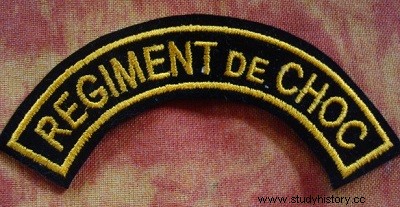
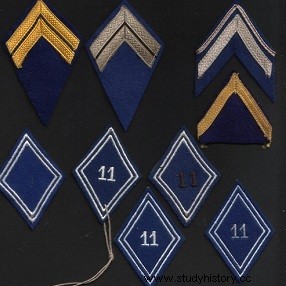
Traditions
Currency
Who dares wins (Who dares wins), motto taken from the SAS units that it shares with the 1st RPIMa of Bayonne (special forces).
Insignia
The unit is famous for its insignia, the Bagheera panther designed by Lieutenant Dupas.
Rank badge (Before 1958)
Non-commissioned members:daffodil colored wool or fibranne stripes,
Junior non-commissioned officers:silver cracked stripes,
Adjutant:ribbed woven stripes gold
Chief warrant officer and officers:braids woven in silver ribbed line
Shoulder title "Shock battalion" in white frame on royal blue cloth background.
Flag
The unit receives its flag while it is still only a battalion. It is that of the 11th infantry regiment disbanded in 1940.
The 11th DBPC receives the flag of the 1st shock regiment.
The 11th RPC receives its flag on February 7, 1986, in the presence of the highest military authorities. After the dissolution of the regiment on June 30, 1993, the CPIS of Perpignan kept the flag of the 11th RPC and the traditions of the 11th shock.
Berets
Before 1958
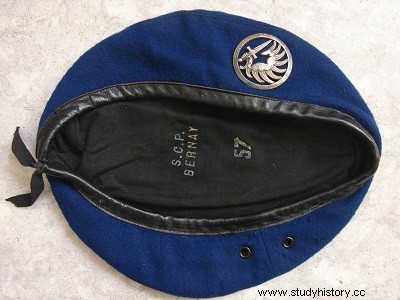
Royal blue beret with insignia of the Metropolitan Airborne Troops. Circled argent a demi vol armed with the same broaching of the extremities. Epaulets in royal blue cloth crest and collar tabs in royal blue cloth with white braiding and white body number (for non-commissioned members) or silver for executives.
After 1958
Red beret common to all paratroopers of the French Army except those of the Foreign Legion.
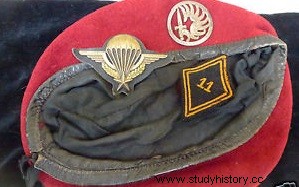
Singing
The Commandos, song written by paratroopers of the 11th Shock during maneuvers in the Tyrol.
Leaders
The list of unit commanders or corps leaders is as follows:
11th parachute shock battalion
1946-1947:captain Mautaint
1947-1947:captain Rivière
1947-1948:captain Aussaresses
1948-1953:chef battalion Godard
1953-1955:Decorse squadron leader
1955-1957:captain Bauer
1958-1960:captain Erouart
1960-1961:battalion commander Crousillac
1961-1962:battalion commander Mouton
1962-1963:battalion commander Dabezies Battalion
1963-1963:Battalion Commander Barthes
1st paratrooper shock battalion
1958-1960:Captain Faury
1960-1961:Major Bichelot
1962-1963:Major Camus
1963-1963 :Captain Gout
12th Parachute Shock Battalion
1955-1958:Captain Mantei
11th parachute shock demi-brigade
1955-1961:Colonel Decorse
1961-1963:Lieutenant-Colonel Merglen
Walking group
1956-1957:Lieutenant-Colonel Decorse
1957-1958:Captain Rocolle
1958-1958:Captain Baven
1958-1959 :battalion chief Mantei
1959-1960 :battalion chief Crousillac
1960-1961 :battalion chief Erouart
1961- 1962:battalion chief Mantei
1962-1962:battalion chief Prevot
11th parachute shock regiment
1986-? :Colonel Patrick Manificat
The following personalities served in the regiment:
General Paul Aussaresses;
Erwan Bergot, French writer and journalist;
General Pierre Crousillac;
Colonel Déodat du Puy-Montbrun, founder of the action service of the SDECE and aide-de-camp to General de Lattre in Indochina;
Yves Guérin-Sérac;
Raymond Muelle, paratrooper officer and French writer;
Guy Penaud, former police commissioner and French historian;
Colonel Jean Sassi, member of the Special Forces during the Second World War and the Indochina War;
chief warrant officer Jo Sohet, took part in the campaigns of Indochina, Suez, Algeria and in operations of the SDECE; chief of harka and Vietnamese auxiliaries; parachutist instructor; writer, lecturer, then parliamentary attaché, specialist in Islamist issues, describes the Indochina campaign in his book Watcher, what about the night; Grand Officer of the Legion of Honor;
Michel Vaillat, Mayor of Lattes and Vice-President of the Languedoc-Roussillon Regional Council;
Colonel Michel Vallette d' Osia.
